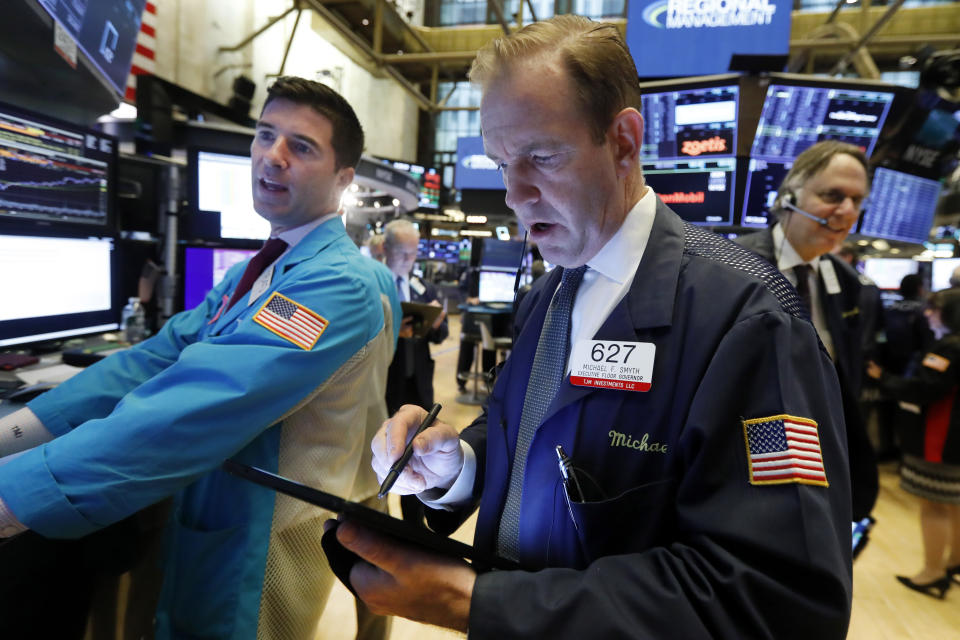Stock market news: November 1, 2019
U.S. stocks jumped Friday and the S&P 500 and Nasdaq closed at record highs after the October jobs report came in well above consensus expectations.
The S&P 500 ended at 3,066.91, a record close, and just 0.04 points below the all-time intraday high it also reached during Friday’s session. The Nasdaq posted a record closing high of 8,386.4. And the Dow ended just 0.04% below its recent closing high from mid-July.
Here’s where markets settled at the end of regular equity trading:
S&P 500 (^GSPC): +0.97%, or 29.34 points
Dow (^DJI): +1.11%, or 300.31 points
Nasdaq (^IXIC): +1.13%, or 94.04 points
10-year Treasury yield (^TNX): +2.8 bps to 1.719%
Gold (GC=F): +0.06% to $1,515.70 per ounce
Optimism over progress in a phase one U.S.-China trade deal added to sentiment. The Office of the U.S. Trade Representative said Friday that Trade Representative Robert Lighthizer and Treasury Secretary Steven Mnuchin held a “constructive call” with China’s Vice Premier Liu He about the first portion of a China trade deal, adding that “they made progress in a variety of areas and are in the process of resolving outstanding issues.”
Earlier, the Bureau of Labor Statistics released its October jobs report Friday morning, showing the economy added 128,000 jobs for the month, well above the tepid 85,000 gains expected.
The unemployment rate edged up to 3.6%, as had been expected, increasingly just slightly from September’s 50-year low of 3.5% and reflecting a still-tight labor market. Hourly wages rose by 0.2% month-on-month, or just below the 0.3% gain expected, and 3.0% year-on-year, matching expectations.
“The strength of this report, together with the news earlier this week of a slightly stronger-than-expected 1.9% annualized gain in third-quarter GDP, would seem to support the Fed’s shift to a more neutral policy stance,” Michael Pearce, senior U.S. economist for Capital Economics, wrote in a note.
“Nevertheless, given the continuing weakness in the survey evidence – and with the knowledge that these employment figures are likely to be revised down significantly when the annual benchmark revision is incorporated early next year – the Fed may not be done yet, even though a December rate cut now look less likely,” he added.
Within October’s headline payrolls figure, manufacturing jobs fell by just 36,000, much better than the loss of 55,000 expected.
Consensus economists had anticipated job gains would soften for the month due primarily to the impact of transitory factors like the United Auto Workers strike on General Motors (GM).
The Labor Department has accounted for 46,000 striking GM workers. These were set to drag on manufacturing payrolls, but not have an impact on the unemployment rate and other measures in the household survey, which classifies striking workers as just temporarily unemployed.
But weaker manufacturing hiring trends have also reflected industry-specific softness, with a well-documented slowdown in goods-producing companies occurring both domestically and abroad amid an ongoing trade war and slowing business capital expenditures.

To this end, the October ISM manufacturing index also released Friday morning reflected the latest extent of the deceleration. The headline index held in contractionary territory for a third consecutive month, coming in at 48.3 versus the 48.9 expected. While this was an improvement from September’s 10-year low of 47.8, it was still below the neutral level of 50, indicating contraction.
Overseas, some signs of life emerged from the manufacturing sector of the world’s second largest economy. China’s Caixin manufacturing index unexpectedly increased to 51.7 from 51.4 in October, indicating expansion.
However, Caixin’s survey weighs private manufacturing companies more heavily, and the results were at odds with a report from the Chinese government Thursday that showed the country’s factory activity dropped to 49.3, the lowest level since February, as the trade war weighed on new export orders.
Elsewhere, earnings season continued to roll on with mixed results.
Newly public company Pinterest (PINS) disappointed investors with lower-than-expected quarterly sales and guidance, diverging from other internet companies including Google (GOOG), Facebook (FB) and Snap (SNAP) that had shown strong advertising sales growth. Shares tanked 20% in overnight trading.
China-based e-commerce giant Alibaba (BABA) topped consensus expectations and posted a 40% jump in revenue, as the firm’s improving shopping recommendations and a bump up in mobile users helped drive estimates-topping results.
—
Emily McCormick is a reporter for Yahoo Finance. Follow her on Twitter: @emily_mcck
Read more from Emily:
FedEx CEO: ‘Whistling past the graveyard’ on the U.S. consumer belies a broader slowdown
There won’t be ‘billion-dollar beverage brands’ in the future: Iris Nova CEO
Iris Nova CEO calls his company the ‘Netflix’ of the beverage space
Tech companies like Lyft want your money – not ‘your opinion’
Follow Yahoo Finance on Twitter, Facebook, Instagram, Flipboard, LinkedIn, and reddit.
